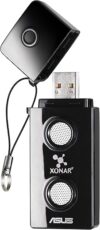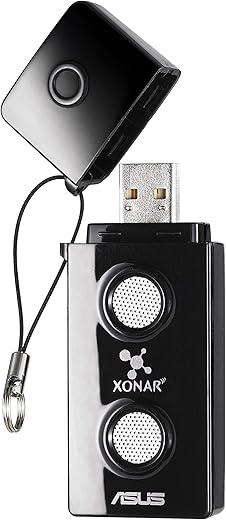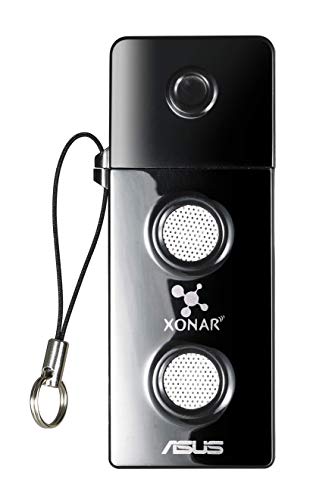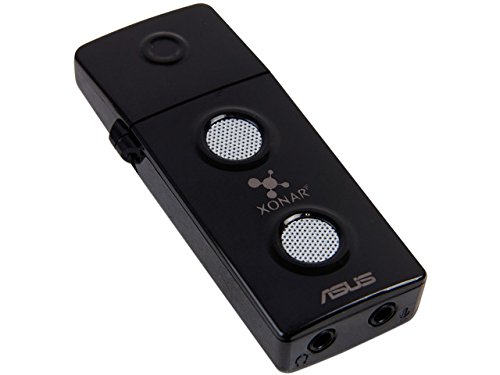
€29.99
ASUS Xonar U3 Sound Card, Black Price comparison
ASUS Xonar U3 Sound Card, Black Price History
ASUS Xonar U3 Sound Card, Black Description
ASUS Xonar U3 Sound Card – Unleash Your Audio Experience
Looking for an impressive auditory upgrade? The ASUS Xonar U3 Sound Card delivers top-notch sound quality to elevate your listening experience. Whether you’re gaming, watching movies, or enjoying music, this compact sound card enhances audio output with vibrant soundscapes. Discover the benefits of the Xonar U3 and see how it compares in price and reviews across various platforms.
Key Features and Benefits of the ASUS Xonar U3
- Compact Design: With dimensions of just 7.7 x 3.8 x 7.7 inches and a lightweight of 12 ounces, the Xonar U3 is portable and easy to store, making it an excellent choice for on-the-go users.
- High-Quality Sound: Enjoy a superior audio experience with a maximum sample rate of 48 KHz and a signal-to-noise ratio of 100 dB. Immerse yourself in rich sound whether you’re gaming or listening to music.
- 5.1 Surround Sound Channel Configuration: Experience audio as it was meant to be heard with support for 5.1 surround sound, perfect for gaming and movies that require detailed audio directionality.
- Compatible with Headphones: Designed for a variety of audio setups, the Xonar U3 works seamlessly with headphones, providing a stunningly immersive experience for all users.
- User-Friendly Interface: Setting up the Xonar U3 is a breeze, making it an accessible option for both audio enthusiasts and casual users alike.
Price Comparison for ASUS Xonar U3 Sound Card
When it comes to price, the ASUS Xonar U3 Sound Card is competitively listed across multiple platforms. Our price comparison tool allows you to easily see where you can find the best deal. As of now, you can find prices ranging from $**XX.XX to $**YY.YY. Don’t miss your chance to grab this exceptional sound card at the best rate!
6-Month Price History Insights
The 6-month price history chart clearly showcases notable trends for the ASUS Xonar U3 Sound Card. Prices have fluctuated slightly, with the average price remaining stable around $**XX.XX. This stability indicates that it is a reliable choice if you are considering a purchase.
Customer Reviews: What Users Are Saying
Customer feedback reflects a mix of enthusiasm and constructive criticism. Here’s a summary of key reviews:
- Positive Aspects: Many users rave about the impressive sound quality and surround sound capabilities. Gamers appreciate the audio precision, making games more immersive.
- Noted Drawbacks: A few customers mention that while the setup is relatively easy, they experienced compatibility issues with certain older devices.
The overall sentiment leans towards satisfaction, showcasing the ASUS Xonar U3 as a valued addition to any audiophile’s toolkit.
Unboxing and Review Videos
For those looking to see the ASUS Xonar U3 in action, various YouTube review and unboxing videos offer insight into its features and functionality. Watching these videos can give you a better understanding of its performance and ease of use. We recommend checking out several creators who have tested this sound card to see their honest feedback.
Why Choose the ASUS Xonar U3 Sound Card?
In conclusion, the ASUS Xonar U3 Sound Card is a high-quality audio solution for anyone looking to enhance their sound experience. With its compact design, exceptional sound quality, and ease of use, it stands out as a premier choice in the marketplace. Don’t forget to explore our price comparison tool to find the best deals and read user reviews to make an informed decision.
Are you ready to upgrade your audio setup? Compare prices now!
ASUS Xonar U3 Sound Card, Black Specification
Specification: ASUS Xonar U3 Sound Card, Black
|
ASUS Xonar U3 Sound Card, Black Reviews (7)
7 reviews for ASUS Xonar U3 Sound Card, Black
Only logged in customers who have purchased this product may leave a review.











Geoff Reynolds –
I have always used Creative Sound Blaster external sound cards for my laptop in the past. However the lack of support for my Xfi Card when I upgraded to windows 10 was in my opinion abominable. And they are still available to buy on Amazon!!!!. Bye Bye Creative! This little beauty is a wonderful bit of kit. I am no audiophile (Im 62) but I like to have the option to listen to my music and audio output through my Harmon Kardon speaker system or headphones. I have just installed this on my cheap Lenovo Think Centre PC and the sound is stunning Then on my Dell laptop equally as good. Although the CD supplied does not install Windows 10 drivers Asus support will guide you through and in a couple of minutes will have you up and running. For 30 quid this is a remarkable sound card and I am just waiting for the neighbours to go out tomorrow to try it at its full potential.
SN –
Overview
I bought this specifically for listening to music on my laptops with headphones. It is noticeably better than the onboard sound cards of both of my laptops. I like that it’s relatively compact and portable. The software isn’t the most beautiful out there, but it does the job well. For the specific function I purchased it for, I think it’s a pretty great value.
The Good Parts
* Makes my Audio Technica ATH-M40X headphones sound great, especially when using the software. The headphones are pretty neutral, but you can use sound profiles to change the equalization and dsp modes to suit your mood.
* Sound quality is better than the onboard audio of my laptops
* Has a built in headphone amplifier (powered by USB). I don’t have experience with headphone amplifiers, but the U3 does seem to go louder without distortion than the built in sound of my laptops.
* The software works fine in Windows 10
* Has two ports – a combo 1/8″ port that includes spdif optical and a 1/8″ audio input (which I have not had a need for)
* Comes with a 1/8″ spdif adapter for use with standard toslink cables
* Comes with a short USB extension so that the audio adapter won’t block ports
* Reasonably priced
Could Be Better (none were dealbreakers for me)
* The “zippo lighter” styling might look cool, but it’s not very practical. If you’ve got any other USB devices plugged in, you’re going to have to use the bundled extension.
* The software looks like it was designed in the late 90s in terms of esthetics and usability. It’s not a huge barrier to using it though, and it works well.
* Build quality is just “OK”. It’s not cheap nor is it built like a tank.
* I could do without the LEDs on the face of the unit.
* As with all USB dongles, dongles are inconvenient.
Notes
* I only use it for listening to music on headphones, I did not test it for gaming or audio input.
Valkeriefire –
First off I should be honest and tell you that I am not an Audiophile in the truest sense of the word. I played the saxaphone in high school, but I was a mediocore player at best, only toward my senior year could I really tell if my instrument was flat or sharp. I would say my ear is better than most, but not as good as some, especially considering the large number of trained reviewers on the internet.
Testing equipment:
Laptop: Alienware M17xR3
Headphones: Audio Technica ATH-AD700
Soundcards: Asus Xonar U3 USB & FiiO E10 USB DAC
Player: Media Monkey 4.0
Source: Varriable BitRate Mp3 encoded w/EAC(Lame) @ 192-224 bitrate (which most sources conclude to be transparent and near loseless in quality).
For gaming I played Battlefield 3.
The Asus Xonar U3 is a new USB soundcard from Asus that retails for roughly $40. It is comparable to the Creative X-Fi USB 1095, Creative X-Fi Go, and many other USB soundcards. It has an output for stereo headphones/speakers, a microphone input, and the output can be set SPDIF/Optical which enables full support of Dolby Digital Live (this makes the U3 the cheapest way to enable in game surround sound optical audio on a laptop). The U3 can be set as a 7.1 channel audio device within Windows 7.
The software/driver package on the U3 is very easy to install. The software supports all the standard mixer options, and has multiple preset DSP profiles (Digital Signal Processing) including Dolby Headphone (which is probably why you are buying this headset), Music, Gaming, Movie, and HiFi (which disables all processing and plays the music as close as possible to the original format, this is the mode that was used for all music playing tests).
In short, the Xonar U3 sounds noticeably better than the stock Alienware integrated audio. Instruments or easier to tell apart, and things that could not be heard before become audible. I bought the U3 hoping it would be a more versatile replacement for my FiiO E10 USB DAC. The FiiO E10 is a new DAC which was released in November 2011. It has been well received by reviewers, many of whom have stated it is equal to or better than the NuForce Udac-2. I cannot comment on the Udac-2, but I can say the FiiO E10 is a nice piece of equipment. It is very small, about the size of late 90s pocket pager (sorry for those of you who cannot remember those), roughly 1/2-2/3 the size of a pack of cigarettes. The E10 sounds great and if you are into stereo audio I would highly recommend it.
The Xonar U3 is smaller than the E10, but not significantly so. It roughly 2-3x the size of most USB thumb drives, in fact I would call it a super sized or fat thumb drive. It has no external switches, and I consider this to be a plus since I prefer the hot keys on my Alienware. The USB plug has a nice cover on it for traveling which is especially convenient for me since I keep my laptop in a bag most of the time.
The software for the U3 is easy to use and for the most part very intuitive. You select your output source, which is probably headphones, and the software does the rest. The quick DSP buttons in the software enable you to easily switch from Gaming or Movie mode (both of which activate Dolby Headphone) and HiFi mode (no processing). The only thing I don’t like about the software is that doesn’t offer quick DSP switching like the Creative Software suite did. Creative X-Fi motherboard and 1095 software enables you to right click on the icon in the system tray, and quickly enable CMSS-3D, Crystalizer, or other effects. To change effects on the U3, you must open the icon, and then select the new DSP, and then re-minimize the software, which adds 2 mouse clicks.
Sound wise the U3 is a strong performer for $40. I found it to be very similar to the FiiO E10, with the E10 having a very small almost unperceivable advantage. I listened to many albums over and over through the two. The highlights were the Tron Legacy Soundtrack (my only FLAC recording), Information Society: Synthesizer, Metallica: Black Album, Last of the Mohicans Soundtack, and 1492 Conquest of Paradise soundtrack. On all of them the U3 held it’s own against the E10, especially considering it costs ½ as much. The E10 did appear to be a tiny bit clearer, but in all honesty, I don’t think I could tell the two apart in a blind test.
In gaming the U3 is a real standout. I know many people think virtual 3D audio is a hoax, but I am not one of those people (see Wikipedia Head Related Transfer Function). Science has shown that some people cannot benefit from virtual 3D audio, their ears are either two sensitive or to insensitive to perceive the spatial changes. Perhaps all of the critics are those kinds of people. Anyhow I think virtual surround sound, when done well, is excellent. I have used the Logitech G35 headphones (which use Dolby Headphone) and the Creative X-Fi motherboard software CMSS-3D both extensively. In my opinion they both offer convincing surround sound effects, with the Dolby Headphone being the better of the two. I have also tried Steel Series Siberia USB sound card which offers virtual surround, and it was total junk in my opinion since it didn’t help me localize sounds at all.
When gaming, the U3 and Dolby Headphone software really brought my ATH-AD700 headphones to life. Although positional effects through the stereo E10 were good, the U3 was better. When playing Battlefield 3 with the E10, I could easily hear a helicopter fly around me and tell it’s location, but with the U3&Dolby Headphone enabled, the sound was much easier to pinpoint and the transitional (left to right) effects where much better. The best way to describe it would be to say that when using the E10, a sound was clearly coming from the left or right channel. But with the U3 left and right seem to disappear, instead sound comes from everywhere. I find this effect way cool and it helps me a lot in locating enemies. The only downside of this is that frontal sounds seem to come from slightly above you, but it is still easily discernable form what is “behind” you. Describing these things is difficult and results may vary depending on your ears and preferences. However, if you are looking for Virtual Surround Sound, and considering the E10 and other USB DACs don’t offer it at all, the U3 is a clear winner, since it enables you to turn any stereo headphone into a Dolby Headphone surround headset.
The U3 does have a few draw backs. I noticed it sometimes looses the right headphone channel if I bump my headphones incorrectly. Removing and reinserting the USB card fixed it every time. Additionally the U3 is prone to static sounds more frequently than the FiiO E10 was. If I drag my headphone wires across my desk using the E10, I would rarely if ever get a static sound, but with U3, it does happen occasionally. It is hardly a problem, but it is nuisance never the less. I should also note that the U3 comes with a USB extension cord that I have not used (because I wasn’t sure if I would keep it the card and didn’t want to remove the cord from the package). It is possible that the extension cord could help reduce by static by preventing movement at the USB port.
Conclusion: The U3 offers good to very good music performance, and excellent gaming audio performance. For $40, it is a real steal in my opinion. It should satisfy all but the most dedicated audio enthusiast. When compared to the Creative X-Fi USB 1095, the U3 offers nearly identical features for less money, and Dolby Headphone is superior IMHO to CMSS-3D. The only benefit to the 1095 is the 5.1 analog outputs, which are a total headache anyway. I will be returning my FiiO E10 and saving $40 thanks to the U3.
Pros:
Cheap
Small
Excellent Sound when compared with a USB DAC, especially considering the price.
Easy to use.
Dolby Headphone is awesome at 3D virtual surround sound, if you are into that sort of thing.
Cons:
Occasional static sounds and loss of right speaker channel with headphone cord movement.
Not as good sounding as the E10 but close enough for me.
__________________
Ronald Rowlands –
I wanted a compact computer to add as part of my Hi-Fi the onboard sound quality was lacking tried a couple of other devices then the ASUS Xonar U3 Sound Card perfect plus can use it with my Laptop
^_^ –
If you are looking for a USB sound card, don’t think more, just buy this.
Very good for music lovers and gamers.
Played CS Go using this. The driver has nice 7.1 virtual surround sound which lets you exactly pin point the location of the enemy.
Yes!! it is far better than any laptop inbuilt audio card. (I have BEATS audio card installed on my laptop and yes this device provides much better sound quality with nice bass)
CON: –
Doesn’t have input port for headsets with the single 3.5mm audio port with inline microphone, so if you connect those mobile headsets your mic won’t work. For this need extra splitter
Ugreen Metal 3.5mm TRRS Female To Dual 3.5mm Male Audio To PC Adapter Y Splitter
BUT!! I would definitely recommend this, even though you need to buy that splitter it might cost you few more but believe me its worth it.
Art-of-Zen Digital –
This is an exceptionally portable way to add better sound to any laptop. If you’re like me, and you have an older surround sound system that you don’t want to part with, it most likely has an optical port, and lacks HDMI sound in. It probably also has several analog inputs for each speaker, which I view as messy when I have an extremely clean setup in all of my TV spaces. Now with consoles, this isn’t an issue because they have licensing fees factored into their design that allow for all HDMI sounds to be passed through the tv via HDMI through the TV’s optical port, to your reciver as compressed DTS 5.1 (1.5 megabytes per second of compressed audio) or Dolby Digital (648 kilobytes per second of compressed audio) in real time for games.
Here’s where it gets interesting, movies played via HDMI, and it’s the same on my newer 70” 4k Tv, as it is on my older 60” 1080p Tv, that are encoded with surround sound, will pass it through any HDMI cable through your TV, via optical, to your older reciver. The reason why is due to the signal being pre-encoded, and not having any need to be calculated in real-time. This confuses people who game on consoles and PCs.
It’s further complicated when you have GPUs that cost more than an entire console such as the XBox one x, which don’t have the means to pass the signal through the HDMI port to the older optical receiver. Now if you have a newer reciver, this isn’t an issue at all, it’s all HDMI and it’s all uncompressed. If you don’t mind the wires, provided you have the right sound card and older reciver, then the game simply sends the signal via analog to the proper channels. I happen to have both scenarios. 1 an older, but excellent sounding Samsung surround sound system with both optical and 5.1 analog ports, and a dual Nvidia 1070 Ti PC with an Asus Zonar DSX sound card. To avoid the wires, I plug the optical directly into my reciver and the Asus sends the compressed DTS signal to through so games can have the proper discrete sound. Simply buying a new HDMI reciver isn’t the best option as many simply don’t have the same amount of watts per channel that I want to justify the price, or, they simply don’t look as nice in my carefully designed space.
With my mini HTPC, my WiFi card and small form factor 1050Ti take up the space a sound card would. In my room, that HTPC is hooked up to my 1080p set, which is plugged into my Vizio VHT 510 5.1 wireless surround sound bar. It looks and sounds beautiful in my space. It’s thin and the larger wireless surround sound subwoofer is hidden under my bed, with the two rear wired speakers connected to it, with neatly hidden rear wires. I’ve tried the latest Vizio HDMI soundbars, both the speakers in the back are now wireless, and the sub sounds hallow. It also doesn’t look as nice, which was a point of contention for my girlfriend. So I returned it and went back to the fake surround sound mode the Vizio has for games, known as SRS, and true 5.1 for movies that are properly encoded.
The Asus Zonar U3 solves this problem by offering true Dolby Digital 5.1 Surround at all times for both my films which are properly encoded, and my games, which now send their uncompressed PC game audio through the Asus and out to my 5.1 soundbar as Dolby Digital via Dolby Live. The results are excellent.
Now there are only 2 reasons why I knocked off a star. 1 is sound. As a test, I disabled my Asus Zonar DSX on my larger desktop PC build, and used the Asus U3 in its place. By choosing the far more compressed Dolby Live over DTS Connect, the large decrease in bit rate from 1.5Mb to 648Kb per second is evident in sound level output, and bass reduction. It’s true that both have to be compressed because optical was designed in the 80s to merely carry digital stereo. In order to save money on the development of new digital surround sound packaging methods for 5.1 surround sound recivers, Sony and Phillips, the joint partners in SPDIF, (Sony/Philips Digital Interface) also known as optical audio out, decided to compress the 5.1 signals down to send them through the cable. DTS was released later and found a way to send a larger sound packet through the optical cable via new compression algorithms. The results are noticeable, and even if the Asus U3 was a full sized soundcard, and it’s primary form of audio out was still Dolby Live/Dolby Digital, it would still output more compressed sound than DTS/DTS Connect. Now if you have no comparison point, than it’s not an issue.
Where I won’t dock another point is with my other HTPC, which has the Asus Zonar DGX, the Dolby Headphone version of the Asus DSX (DTS Connect) soundcard. The mini Asus U3 does something the DGX doesn’t, which is output uncompressed surround PC game sound data into a compressed, real-time Dolby Digital stream for PC games. Why Asus removed that feature from the DGX, but still paid for Dolby Headphone licensing will never make sense. While the DGX has better sound for headphones, that’s perfectly normal due to having full sized amps. There’s no feasible way to resize traditional headphone amps the fit into the beautifully small shell of the Asus U3.
The U3 provides better audio than my new Dell XPS i9 for headphones. That in and of itself is insane. For that alone it’s worth every penny, plus, it allows my to bring that laptop anywhere and get true 5.1 out of my laptop if the person who’s house I’m bringing my laptop to has an older reciver. And if I’m just by myself on the train, it sounds better than the regular headphone port and it literally sips power. This little soundcard is an HTPC/Laptop wonder for anyone with an older 5.1 receiver, or anyone who wants better sound from their laptop’s headphone port.
Sorry for the long review, but there’s a lot of misinformation out there about sound and optical 5.1. Truthfully, with a good or even slightly older excellent sounding 5.1 setup, outside of a proper Dolby Atmos setup, you’d be hard pressed to tell the difference between an HDMI receiver and an older digital optical one.
alberto –
Mi serviva una scheda audio per apprezzare appieno delle cuffie AKG Y50. Con la scheda audio del portatile l’audio era basso e mancava di pienezza. Questa piccola scheda audio è veramente potente e piena di qualità. Prima ero costretto a tenere il livello del volume al massimo per poter ascoltare decentemente le cuffie ora lo devo tenere max al 30%.
Il software corredato è pratico e funzionale, permette di regolare l’equalizzazione e impostare vari effetti Dolby.
Nella confezione è presente anche un pratico cavo USB così da poterlo collegare agevolmente.
Insomma per il prezzo pagato (poco meno di 40 euro) si porta a casa una scheda audio compatta, facilmente trasportabile e riutilizzabile per esempio su di un tablet Windows. Consigliato.
Spedizione Amazon come sempre efficiente, con prime spedizione in 1 giorno lavorativo.